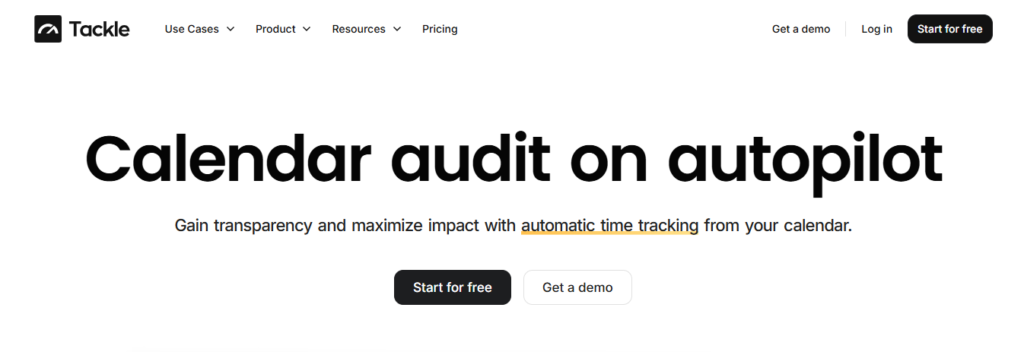Planning weekend habits or building staff rosters in the Best Free Habit Tracker App starts with a simple calendar question: how many Saturdays are in a year? Some years have 52 Saturdays, some 53, and the position of January 1 or a leap year can change the weekend count, which affects your annual calendar, shift planning, payroll cycles, and holiday overlap. This article shows how to count Saturdays, spot years with extra weekend days, and use that insight to make more competent workforce scheduling decisions.
To help you put this into practice, Tackle’s automatic time tracking software makes it easy to map Saturdays to shifts, track weekend hours, and adjust rosters without fuss.
How Many Saturdays Are in a Year? The Straightforward Answer

A regular year has 365 days. That breaks into 52 full weeks plus one extra day, which guarantees at least 52 Saturdays. The leftover day shifts the calendar, and if that extra day falls on Saturday, you end up with a 53rd Saturday. Check which weekday January 1 lands on to see whether you get a 53rd Saturday.
When a Year Will Have 53 Saturdays
In a non-leap year, the weekday of January 1 is the one that appears 53 times. So, a non-leap year that begins on a Saturday contains 53 Saturdays. In a leap year, there are two extra days.
If January 1 or January 2 is a Saturday in a leap year, then that year contains 53 Saturdays. Leap years occur every four years, with the century exceptions, so those extra days change how often Saturdays repeat.
Quick Example and a Simple Test You Can Use
2025 is not a leap year, and it starts on a Wednesday, so it has 52 Saturdays. If the year is not a leap year, check if January 1 is a Saturday. If the year is a leap year, check January 1 and January 2.
Related Reading
- Happy Friday Meme
- How Many Work Weeks in a Year
- Friday Memes for Work
- Leadership Interview Questions
- How Many Weekend Days in a Year
- How Many Working Hours in a Month
Impact on Workforce Management

A common year has 365 days, which equals 52 weeks plus one day, so one weekday appears 53 times; in a leap year with 366 days, two weekdays appear 53 times. That means most years have 52 Saturdays, and some years have 53 Saturdays, depending on how the calendar falls.
Payroll Impact of a 53rd Saturday
An extra Saturday can raise labor costs for hourly and weekend staff, mainly where weekend premiums or overtime rules apply. Budget forecasts that assume 52 Saturdays will understate wages in years with 53, so adjust annual payroll lines and cash flow projections to avoid surprises. Also, audit collective bargaining agreements and local pay rules that trigger different rates for extra weekend shifts.
Scheduling and Coverage When Weekends Change
Retail, hospitality, and healthcare must rework shift rotations, coverage maps, and days off when an extra Saturday appears in the schedule. Managers should rebalance shifts to keep hours fair, prevent burnout, and preserve service levels.
Productivity Metrics and Year-over-Year Comparisons
A 53rd Saturday can skew weekly averages for revenue, billable hours, and output metrics if you compare raw totals across years. Adjust comparisons by using per day, per week, or normalized measures so your KPIs reflect actual performance changes. Also, flag reporting windows in dashboards so analysts know when a calendar anomaly affects trends.
Practical Steps for Workforce Managers
Run a simple calendar audit now. Determine whether this year has 52 or 53 Saturdays, calculate the payroll delta, and update staffing forecasts accordingly. Communicate schedule changes early, offer choices to employees, and document any policy or contract adjustments you make. Track outcomes for the next quarter to see whether your mitigations maintained service and controlled cost.
How Automated Time Capture Eases the Load
Automatic capture through calendar integration removes manual timesheet errors and makes it easier to spot extra weekend hours as they happen. Use tools that tag calendar events, classify billable time, and generate reports that separate Saturday work from weekday output. That visibility lets you model the actual cost of an additional Saturday and adjust hiring, budgets, and performance targets without manual reconciliation.
Seamless Time Tracking with Tackle
Tackle revolutionizes time tracking with seamless calendar integration that eliminates manual logging and captures categorized time automatically. Start using our automatic time tracking software for free with one click today!
Planning for “Extra Saturday” Years

An extra Saturday in the year adds one more weekend day to staff, track hours, and pay. Begin by scanning the calendar years within your planning horizon and marking any year that yields 53 Saturdays.
Ask how many Saturday shifts you run per week and which roles typically cover them. Use those counts to build scenarios that show how one extra Saturday moves weekly hours, overtime triggers, and total annual labor cost.
Which Years Give You 53 Saturdays? Fast, Accurate Rules
A common year has 365 days, so one weekday appears 53 times:
- The weekday of January 1
A leap year has 366 days, so two weekdays appear 53 times:
- The weekdays of January 1 and January 2
That means a year will have 53 Saturdays when either a common year starts on Saturday or when a leap year starts on Friday or Saturday. For example, 2028 is a leap year that begins on Saturday, and 2033 is a common year that starts on Saturday, so both will include 53 Saturdays. Check your payroll and roster against these rules to avoid surprises.
How an Extra Saturday Impacts Budgeting and Scheduling
Quantify the cost before you adjust rosters. Multiply the number of Saturday shifts by average shift hours and pay rate to get the direct wage hit from one extra Saturday. Then model overtime: if an extra Saturday pushes weekly hours past your overtime threshold, you add a premium rate for the affected hours.
Spread the added hours across staff with rotation or voluntary sign-ups to limit overtime exposure. Use weekly forecasting to flag any pay period likely to exceed budget and ask whether you can cover demand with part-time hours, temporary hires, or shift swaps.
Make Systems Flexible Enough to Handle the Extra Saturday
Use scheduling and time tracking tools that let you simulate a year with 53 Saturdays and generate alerts for overtime and budget breaches. Automate recurring Saturday shifts so the system applies the rule consistently. Configure payroll rules for weekend premiums and overtime thresholds, and run a test payroll for any year that includes 53 Saturdays to see the dollar impact. Set up reports that show projected hours by week and let managers approve exceptions before they create unexpected costs.
Related Reading
- Funny Timesheet Reminder Meme
- How to Make Time Go Faster at Work
- Team Lead Interview Questions
- Submit Your Timesheet Meme
- Cute Friday Memes
- Recruitment Campaign
Leveraging Time Tracking Tools

Time tracking software provides precise, real-time visibility into labor hours and payroll costs, making scheduling Saturdays less of a guesswork. Set up clock-in and clock-out rules, require shift confirmations, and capture actual hours by role. That data flows into payroll and reports, so you see weekend labour spend as it happens rather than after the fact.
How Many Saturdays Are in a Year and Why That Matters for Scheduling
A normal year has 365 days, which equals 52 full weeks plus one extra day, so most years have 52 Saturdays. Some years show 53 Saturdays when the extra day lands on a Saturday.
In leap years, there are 366 days, which equals 52 weeks plus two extra days, increasing the chance of a 53rd Saturday depending on which weekdays the year starts on. That extra Saturday can significantly impact payroll and coverage if you leave planning to chance.
Automate Recurring Saturday Shifts so Coverage Stays Tight
Build recurring Saturday shifts once and stop recreating schedules week after week. Use templates for roles and hours, assign rotation patterns, and add approval rules so managers confirm changes. When an extra Saturday appears in a 53-week year, edit the template and push the shift across the roster to avoid gaps and avoid a last-minute scramble for staff.
Forecast Labour Costs Across Weeks and Months with Scenario Planning
Time tracking systems can project weekend staffing costs across weeks, months, and quarters. Include overtime rules, shift differentials for weekends, and seasonal demand drivers when you run scenarios. Compare a 52 Saturday scenario with a 53 Saturday scenario to see the marginal cost of that extra day and decide whether to hire temporary staff or adjust hours to control budgets.
Identify Patterns in Weekend Productivity from Historical Data
Pull reports that show sales per Saturday, no-show rates, overtime spikes, and hours worked by role. Heat maps and trend lines reveal which Saturdays regularly outperform or underperform. Use that insight to schedule more servers, cashiers, or technicians only on high-demand Saturdays and reduce coverage on slower ones to protect margin.
Practical Setup Checklist for Saturday Friendly Time Tracking
- Choose a tool that supports recurring shifts, exceptions, and payroll integration.
- Configure weekend shift differentials and overtime thresholds in the system.
- Create Saturday shift templates for each role and assign availability windows.
- Set up alerts for unfilled Saturday shifts and late timesheet submissions.
- Run two budget scenarios each quarter, one assuming 52 Saturdays and one assuming 53 Saturdays.
- Train managers on how to edit recurring schedules and apply exceptions for extra Saturdays.
Questions to Ask When You Review Your Saturday Plan
- Which Saturdays last year drove the most overtime?
- What would one extra Saturday cost this quarter?
- Do your scheduling rules automatically prevent double booking or excessive overtime for weekend shifts?
Alongside these planning questions, you can explore ways to boost weekend productivity to get more out of Saturdays.
Start Using Our Automatic Time Tracking Software for Free with One Click Today

Tackle removes manual time logging by reading your calendar and turning events into usable time data. Connect Google or Outlook, and the platform captures meetings, blocks, and events automatically. Smart tagging maps entries to projects and categories while AI automations handle repetitive rules.
You get dashboards that show who spent hours where, flexible reporting to measure strategy versus execution, and an in-browser capture that keeps tracking invisible to end users. Teams at Roblox, Deel, and Lightspeed Ventures use Tackle to audit meeting load and allocate focus time, and you can start with one click for free today.
How Tackle Captures and Categorizes Every Meeting and Block
Tackle reads event titles, durations, attendees, and calendar context to classify time. You create tag rules that match keywords, meeting owners, or attendee lists. The AI suggests tags and refines categorization so you do less tuning over time.
Private events stay private under user settings, while team-level reporting still shows totals. The system aggregates time into buckets, such as meetings, deep work, client calls, and administrative tasks, allowing you to compare hours across projects.
Set Up in Minutes: Connect Your Calendar, Create Tags, Turn on Automation
Connect Google or Outlook, name a few tags, and apply simple rules. Example rules assign all events with client names to a client tag and meetings with five or more attendees to a team tag. Turn on auto tagging suggestions and watch the platform learn. Add teammates, set reporting ranges (such as week, month, or year), and schedule recurring exports for CSV or BI feeds.
Reports That Show Hours, Saturdays, and Where Time Really Goes
Tackle’s reports let you slice time by day of the week so you can answer questions like how many Saturdays your team spent on client work. The platform exposes day of the week frequency, allowing you to count Saturdays in any interval, display weekend days per year, and identify months with five Saturdays or an extra weekend load.
You can filter by calendar year to compare week totals, or look across leap years to see how the extra day affects weekday occurrences.
Try It: One-Click Setup and Instant Day of Week Reports
Connect your calendar, create a few tags, and run a year-long report to answer questions like how many Saturdays are in this fiscal year and how many of those Saturdays included meetings. Then tweak rules or automations to reduce weekend load or reallocate tasks to weekdays so your team gets more protected time without extra logging
Related Reading
- Unique Questions to Ask Leaders
- How Many Hours Do People Work in a Year
- How Many Days in the Year Without Weekends
- Benjamin Franklin Schedule
- Recruitment Campaign
- Payroll Reminder Meme
- Standard Work Hours in a Year


